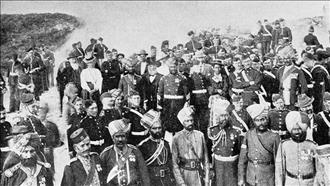 One of the more obscure pages of generally forgotten New Zealand history is the time Indian soldiers (Muslim, Hindu, Sikh and Ghurkha) paraded the streets from Auckland to Invercargill more than 100 years ago.
One of the more obscure pages of generally forgotten New Zealand history is the time Indian soldiers (Muslim, Hindu, Sikh and Ghurkha) paraded the streets from Auckland to Invercargill more than 100 years ago.
The men were selected from the British Indian Army to attend the January 1901 festivities of the Commonwealth of Australia. There were 34 ‘native’ officers and 66 non-commissioned, plus five Hindi speaking ‘European’ officers, representing various units and formations from the Indian subcontinent.
The ensemble was led by a Rajput Colonel Dadbha of the Jamnagar Indian Service Cavalry and his deputy Rissaldar-Major Mirza Khan of the 18th Bengal Lancers.
Khan was known for his horsemanship and bore ‘the reputation of being the foremost horseman in India.’ He also possessed a sword and silver-mounted dagger presented respectively by Field Marshal Lord Frederick Roberts and the Prince of Wales (who later became King Edward VII) as a prize for the champion all-round man in the mounted military exercises at the Gymkhana in Calcutta in 1875.
New Zealand tour
Overall, the Indian Representative Corps made such an overwhelmingly positive impression in Australia that the New Zealand Government insisted on bringing them to these shores and they toured towns and cities exhaustively for a whole month.
On 11 February 1901, 100 Indian soldiers and army officers traveling on board the Royal Indian Marine Ship ‘Dalhousie’ landed in Auckland, accompanied by 70 ‘camp followers’ (cooks, grooms and servants). The men were met and greeted by a coterie of petty politicians, the teetotaller Mayor David Goldie (1842–1926) and Rabbi Samuel Aaron Goldstein (1852–1935). A week later, after a quick tour of the city and Rotorua, the men paraded before 10,000 spectators (some of whom had travelled from the Waikato and Coromandel) at the Auckland Cricket Grounds.
The Indian Contingent then travelled the North Island, visiting Napier, Woodville, Wanganui and New Plymouth, where civic receptions were the order of the day.
In Wanganui on February 23, 1901, “huge crowds lined the route. The Indians were greatly admired. Independent groups of Maoris greatly amused the Indians by hakas.”
On February 25, the men paraded through Wellington, down Vivien Street, along Cambridge Terrace, around Courtney place, assembling at the Band Rotunda where they were officially addressed and welcomed by the Prime Minister Richard Seddon (1845-1906).
The men then sailed into Nelson on February 26, paraded and then journeyed to Lyttelton. Travelling via the railway network, they stopped to formally parade and march through the streets of Christchurch, Ashburton, Timaru and Dunedin on March 4, Mataura and Invercargill before returning to Lyttelton from whence they sailed on March 6 and left New Zealand forever.
Great reception
The men of the Indian Contingent were extremely well received by officials and the public. In his report, Colonel A P Penton, Commandant of the Defence Forces of New Zealand said, “They were heartily welcomed by the people of New Zealand at each place they visited.”
Contemporary newspapers raved enthusiastically (if curiously) about the men’s masculinity, physique, height, calves, marvellous countenance and the finer details of their colourful turbans and uniforms.
For example, Major Mirza Khan, described as ‘a panther of a man,’ was wearing a scarlet uniform with blue facings, gold lace and a blue puggry (a scarf worn around hat or headgear).
The Christchurch Press reported: “I came across a handsome blue-eyed Afghan. “Shtele-Mashi” I remarked, and before the next word of salutation, ‘Kushali,’ could leave my lips an Afridi from Tirah had my hand in brotherly grip.”
Fiji ‘Colony’
Most curiously, this was not the last visit to New Zealand by representatives of the Indian military. During January and February 1922 a ‘high caste Indian,’ Lieutenant Hisamuddin Khan, DSO (Distinguished Service Order) of the 23rd Indian Cavalry Frontier Force, visited with Pundit Goobind Sahay Sharma, a member of the Legislative Council of the United Provinces, and undertook some fishing at Taupo and Rotorua. Lieutenant Khan and Sharma had been deputed by the Indian Government to inquire “whether Fiji would be a ‘suitable colony’ for the settlement of retired Indian army men.”
In the final analysis, the significance of this particular historical case study is that it speaks volumes about the complex and often paradoxical relationship between colonial and imperial politics of the era on the one hand, and culture and religion on the other.
Though British settler ‘Society’ in New Zealand of the 1900s maintained a negative attitude towards Asian immigration, it was also increasingly aware of its reliance on Indian soldiery for the wider defence of the realm.
This reminds readers that politics (like society) is constantly evolving, multifaceted and at times troublingly ambiguous.
Curiously this entire episode remains little known to this day.
About the Photograph
The Imperial Indian Contingent was made up of troops from all the regiments, both Indian and British, in the Indian Army. In 1901, it toured Australia and New Zealand to reinforce the bonds of empire, and to mark the Federation of Australia.
India at this time was regarded as the ‘Jewel in the Crown’ of the British Empire.
Many New Zealanders gained their main knowledge of India through the popular writings of English author Rudyard Kipling.
At a time when few Indians lived in New Zealand, the exotic appearance of the Indian troops in the contingent attracted a lot of attention.
In this photograph, the touring contingent observes a geyser at Rotorua’s Whakarewarewa thermal resort.

Photo Courtesy: ‘Sir George Grey Special Collections,’ Auckland Libraries. Reproduction Approval: AWNS-19010301-8-1.
Editor’s Note: The above picture is an Auckland Libraries copyright and hence should not be used or reproduced anywhere in any form.
Abdullah Drury is an ardent student of history with a penchant for research. He is a regular contributor to Indian Newslink. The above article augurs well with ANZAC Day being observed on April 25, 2014.




